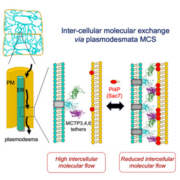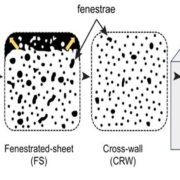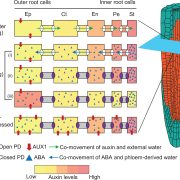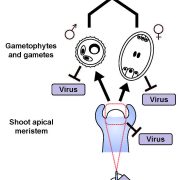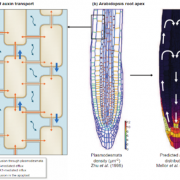Plant cell-to-cell communication constrains viroid quasispecies
Wu and Bisaro study the sequence structure of viroid quasispecies in plant cells.
https://doi.org/10.1093/plcell/koae012
Jian Wu1,2,3 and David M. Bisaro3
1State Key Laboratory for Managing Biotic and Chemical Threats to the Quality and Safety of Agroproducts, Institute of Plant Virology, Ningbo University, Ningbo 315211, China
2Key Laboratory of Biotechnology in Plant Protection of MARA and Zhejiang Province, Institute of Plant Virology, Ningbo University, Ningbo 315211, China
3Department of Molecular Genetics, Center for Applied Plant Sciences, Center for RNA Biology, and Infectious Diseases Institute, The Ohio State University, Columbus, Ohio, 43210, United States of America
Background: RNA viroids, minute infectious agents, have high mutation rates, resulting in diverse populations known as quasispecies. Despite this mutability, viroid quasispecies exhibit remarkable stability in sequence structure. Typically, a few master sequences dominate, while numerous variants also exist. Plasmodesmata, which enable communication between cells and regulate RNA movement, may play an important role in constraining viroid sequence diversity.
Question: This study employed potato spindle tuber viroid (PSTVd) to explore constraints on viroid quasispecies. In particular, we examined the role of plasmodesmata and initial viroid population sequence structure.
Findings: Unexpectedly, a higher accumulation of PSTVd variants was observed in isolated guard cells and in vitro-cultivated mesophyll protoplasts compared to whole leaves. Remarkably, plant cells were found to be susceptible to multiple infections by the same or different variants, enabling the coexistence of multiple variants within a single cell. Co-infection experiments revealed a higher emergence of novel variants in populations initially lacking a master sequence. This underscores the significance of plasmodesmata-mediated cell-to-cell communication and the initial sequence composition as two key constraints on PSTVd quasispecies.
Next steps: Subsequent research should delve into the molecular intricacies involved, unraveling the contributions of initial viroid sequences and cell-to-cell communication to quasispecies evolution. This deeper understanding holds potential implications for devising strategies to manage viroid infections in plants.
Reference:
Jian Wu and David M. Bisaro. (2024). Cell-cell communication and initial population composition shape the structure of potato spindle tuber viroid quasispecies. https://doi.org/10.1093/plcell/koae012



